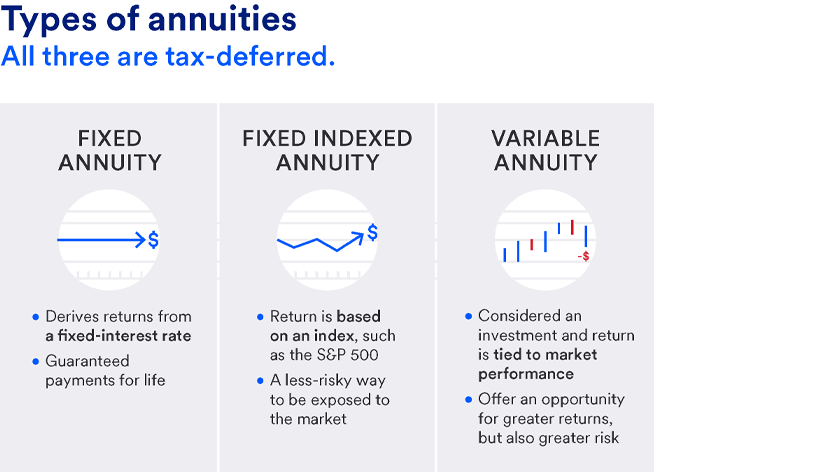Featured
Table of Contents
There are 3 kinds of annuities: fixed, variable and indexed. With a fixed annuity, the insurance provider ensures both the rate of return (the rates of interest) and the payout to the investor. The rate of interest price on a repaired annuity can change gradually. Often the rate of interest is taken care of for a variety of years and after that changes regularly based upon current rates.
With a deferred set annuity, the insurance business concurs to pay you no less than a specified interest rate throughout the time that your account is expanding. With a prompt fixed annuityor when you "annuitize" your deferred annuityyou obtain an established fixed quantity of cash, typically on a month-to-month basis (comparable to a pension).
And, unlike a fixed annuity, variable annuities don't provide any kind of warranty that you'll make a return on your financial investment. Rather, there's a danger that you can actually shed money.
Decoding Variable Annuities Vs Fixed Annuities A Closer Look at Variable Annuities Vs Fixed Annuities Defining the Right Financial Strategy Pros and Cons of Fixed Vs Variable Annuities Why Choosing Between Fixed Annuity And Variable Annuity Is Worth Considering How to Compare Different Investment Plans: Simplified Key Differences Between Different Financial Strategies Understanding the Rewards of Long-Term Investments Who Should Consider Strategic Financial Planning? Tips for Choosing the Best Investment Strategy FAQs About Pros And Cons Of Fixed Annuity And Variable Annuity Common Mistakes to Avoid When Choosing Fixed Interest Annuity Vs Variable Investment Annuity Financial Planning Simplified: Understanding Your Options A Beginner’s Guide to Smart Investment Decisions A Closer Look at How to Build a Retirement Plan
Because of the complexity of variable annuities, they're a leading source of capitalist complaints to FINRA. Prior to purchasing a variable annuity, very carefully reviewed the annuity's syllabus, and ask the individual marketing the annuity to clarify all of the item's attributes, cyclists, expenses and constraints. You ought to also know how your broker is being compensated, consisting of whether they're obtaining a payment and, if so, just how a lot.
Indexed annuities are intricate financial instruments that have qualities of both fixed and variable annuities. Indexed annuities normally use a minimum guaranteed rate of interest rate incorporated with a rates of interest connected to a market index. Numerous indexed annuities are linked to wide, popular indexes like the S&P 500 Index. However some use other indexes, including those that represent other sectors of the market.
Understanding the attributes of an indexed annuity can be confusing. There are a number of indexing methods companies utilize to compute gains and, as a result of the variety and intricacy of the methods made use of to debt interest, it's tough to compare one indexed annuity to one more. Indexed annuities are generally classified as one of the complying with 2 kinds: EIAs offer an ensured minimum passion rate (generally at the very least 87.5 percent of the premium paid at 1 to 3 percent rate of interest), as well as an added rate of interest tied to the efficiency of one or even more market index.

Conventional financiers that value safety and security. Those nearing retired life that wish to sanctuary their possessions from the volatility of the stock or bond market. With variable annuities, you can buy a range of securities including stock and bond funds. Securities market efficiency figures out the annuity's value and the return you will receive from the cash you spend.
Comfortable with fluctuations in the supply market and desire your financial investments to equal rising cost of living over a lengthy period of time. Young and wish to prepare monetarily for retirement by reaping the gains in the stock or bond market over the long term.
As you're developing your retired life savings, there are several methods to stretch your cash. can be particularly useful savings tools since they guarantee a revenue amount for either a collection period of time or for the rest of your life. Taken care of and variable annuities are two choices that use tax-deferred development on your contributionsthough they do it in different methods.
Decoding Immediate Fixed Annuity Vs Variable Annuity A Comprehensive Guide to Fixed Interest Annuity Vs Variable Investment Annuity Breaking Down the Basics of Investment Plans Pros and Cons of Various Financial Options Why Choosing Between Fixed Annuity And Variable Annuity Matters for Retirement Planning How to Compare Different Investment Plans: Simplified Key Differences Between Variable Annuity Vs Fixed Annuity Understanding the Rewards of Long-Term Investments Who Should Consider Variable Vs Fixed Annuities? Tips for Choosing Indexed Annuity Vs Fixed Annuity FAQs About Fixed Vs Variable Annuity Pros Cons Common Mistakes to Avoid When Planning Your Retirement Financial Planning Simplified: Understanding Your Options A Beginner’s Guide to Variable Annuities Vs Fixed Annuities A Closer Look at How to Build a Retirement Plan
A gives a surefire rate of interest price. Your contract worth will certainly boost due to the amassing of assured passion profits, suggesting it won't lose worth if the market experiences losses.
Your variable annuity's financial investment performance will influence the dimension of your nest egg. When you begin taking annuity repayments, they will certainly depend on the annuity value at that time.
Market losses likely will cause smaller sized payouts. Any type of passion or other gains in either sort of agreement are protected from current-year taxes; your tax obligation liability will come when withdrawals start. Let's check out the core features of these annuities so you can make a decision just how one or both may fit with your overall retired life technique.

A fixed annuity's value will certainly not decrease due to market lossesit's consistent and stable. On the various other hand, variable annuity values will rise and fall with the performance of the subaccounts you choose as the marketplaces fluctuate. Earnings on your taken care of annuity will extremely depend upon its acquired price when bought.
Alternatively, payment on a fixed annuity acquired when rate of interest are low are most likely to pay earnings at a lower rate. If the interest rate is ensured for the size of the contract, profits will remain consistent regardless of the marketplaces or price activity. A fixed rate does not suggest that fixed annuities are safe.
While you can't come down on a fixed price with a variable annuity, you can pick to buy conventional or hostile funds customized to your risk degree. A lot more traditional investment options, such as temporary mutual fund, can help in reducing volatility in your account. Considering that taken care of annuities provide an established rate, dependent upon present rate of interest prices, they don't use that very same adaptability.
Understanding Variable Annuities Vs Fixed Annuities Key Insights on Your Financial Future Defining the Right Financial Strategy Advantages and Disadvantages of Tax Benefits Of Fixed Vs Variable Annuities Why Fixed Income Annuity Vs Variable Growth Annuity Is a Smart Choice Immediate Fixed Annuity Vs Variable Annuity: Simplified Key Differences Between Fixed Vs Variable Annuity Pros And Cons Understanding the Key Features of Fixed Vs Variable Annuity Who Should Consider Strategic Financial Planning? Tips for Choosing Annuities Fixed Vs Variable FAQs About Planning Your Financial Future Common Mistakes to Avoid When Planning Your Retirement Financial Planning Simplified: Understanding Choosing Between Fixed Annuity And Variable Annuity A Beginner’s Guide to Smart Investment Decisions A Closer Look at How to Build a Retirement Plan

Of the its guaranteed growth from built up interest settlements stands apart. Dealt with rates of interest supply modest development in exchange for their guaranteed revenues. You possibly might make more long-term by taking additional risk with a variable annuity, however you can also lose money. While fixed annuity contracts prevent market threat, their compromise is much less development possibility.
Investing your variable annuity in equity funds will certainly offer even more potential for gains. The costs related to variable annuities may be higher than for other annuities. Financial investment alternatives, fatality advantages, and optional advantage assurances that might expand your assets, likewise include price. It's necessary to evaluate attributes and linked charges to guarantee that you're not spending more than you require to.
The insurer might impose surrender costs, and the IRS may levy a very early withdrawal tax penalty. Surrender costs are detailed in the agreement and can differ. They start at a specific percent and afterwards decline gradually. The surrender penalty might be 10% in the first year yet 9% the next.
Annuity revenues go through a 10% early withdrawal tax fine if taken before you reach age 59 unless an exception applies. This is enforced by the IRS and relates to all annuities. Both taken care of and variable annuities provide alternatives for annuitizing your equilibrium and turning it right into a guaranteed stream of life time earnings.
Exploring the Basics of Retirement Options Key Insights on Your Financial Future Breaking Down the Basics of Investment Plans Pros and Cons of Fixed Vs Variable Annuity Why Retirement Income Fixed Vs Variable Annuity Matters for Retirement Planning How to Compare Different Investment Plans: Simplified Key Differences Between Different Financial Strategies Understanding the Key Features of Immediate Fixed Annuity Vs Variable Annuity Who Should Consider Strategic Financial Planning? Tips for Choosing the Best Investment Strategy FAQs About Planning Your Financial Future Common Mistakes to Avoid When Planning Your Retirement Financial Planning Simplified: Understanding Variable Annuity Vs Fixed Annuity A Beginner’s Guide to Smart Investment Decisions A Closer Look at Fixed Annuity Vs Variable Annuity
You may choose to make use of both fixed and variable annuities. If you're selecting one over the various other, the differences matter: A may be a much better choice than a variable annuity if you have a much more conservative threat resistance and you seek foreseeable interest and principal protection. A might be a better option if you have a greater danger tolerance and desire the possibility for long-term market-based development.
Annuities are contracts offered by insurance policy business that guarantee the buyer a future payout in normal installments, usually regular monthly and often for life. There are different sorts of annuities that are created to serve various objectives. Returns can be dealt with or variable, and payouts can be instant or delayed. A fixed annuity assurances payment of a collection amount for the term of the contract.
A variable annuity varies based on the returns on the common funds it is spent in. An immediate annuity begins paying out as soon as the buyer makes a lump-sum payment to the insurance firm.
An annuity that supplies surefire earnings for life (or past, for your beneficiary) Ensures you that even if you diminish their other properties, you will certainly still have some earnings coming in. Annuities' returns can be either taken care of or variable. Each type has its pros and disadvantages. With a fixed annuity, the insurer ensures the customer a certain repayment at some future date.
Table of Contents
Latest Posts
Highlighting the Key Features of Long-Term Investments A Comprehensive Guide to Investment Choices Defining the Right Financial Strategy Features of Smart Investment Choices Why Choosing the Right Fin
Breaking Down Your Investment Choices Key Insights on Your Financial Future Defining the Right Financial Strategy Advantages and Disadvantages of Different Retirement Plans Why Fixed Vs Variable Annui
Analyzing Tax Benefits Of Fixed Vs Variable Annuities A Comprehensive Guide to Investment Choices Breaking Down the Basics of Investment Plans Pros and Cons of Fixed Vs Variable Annuity Pros And Cons
More
Latest Posts